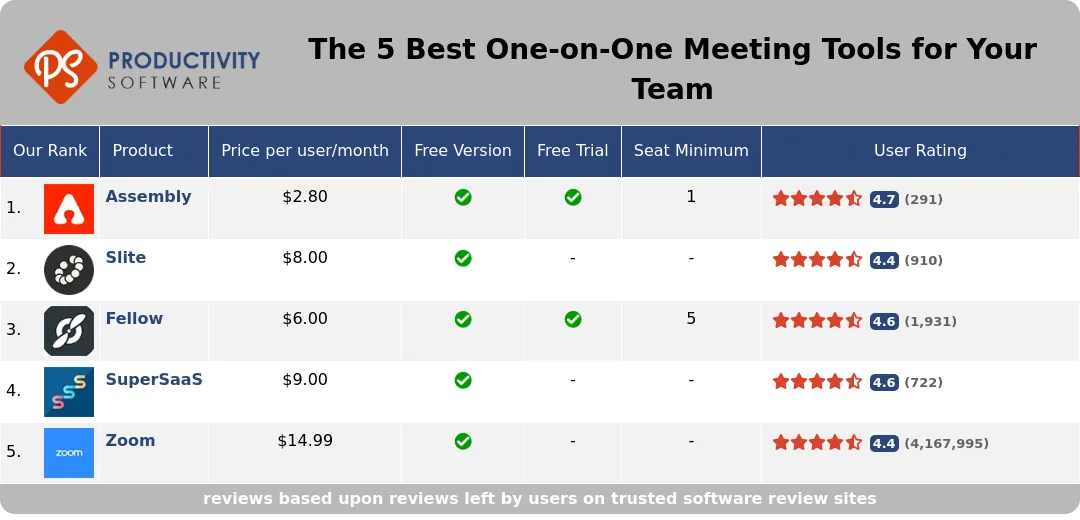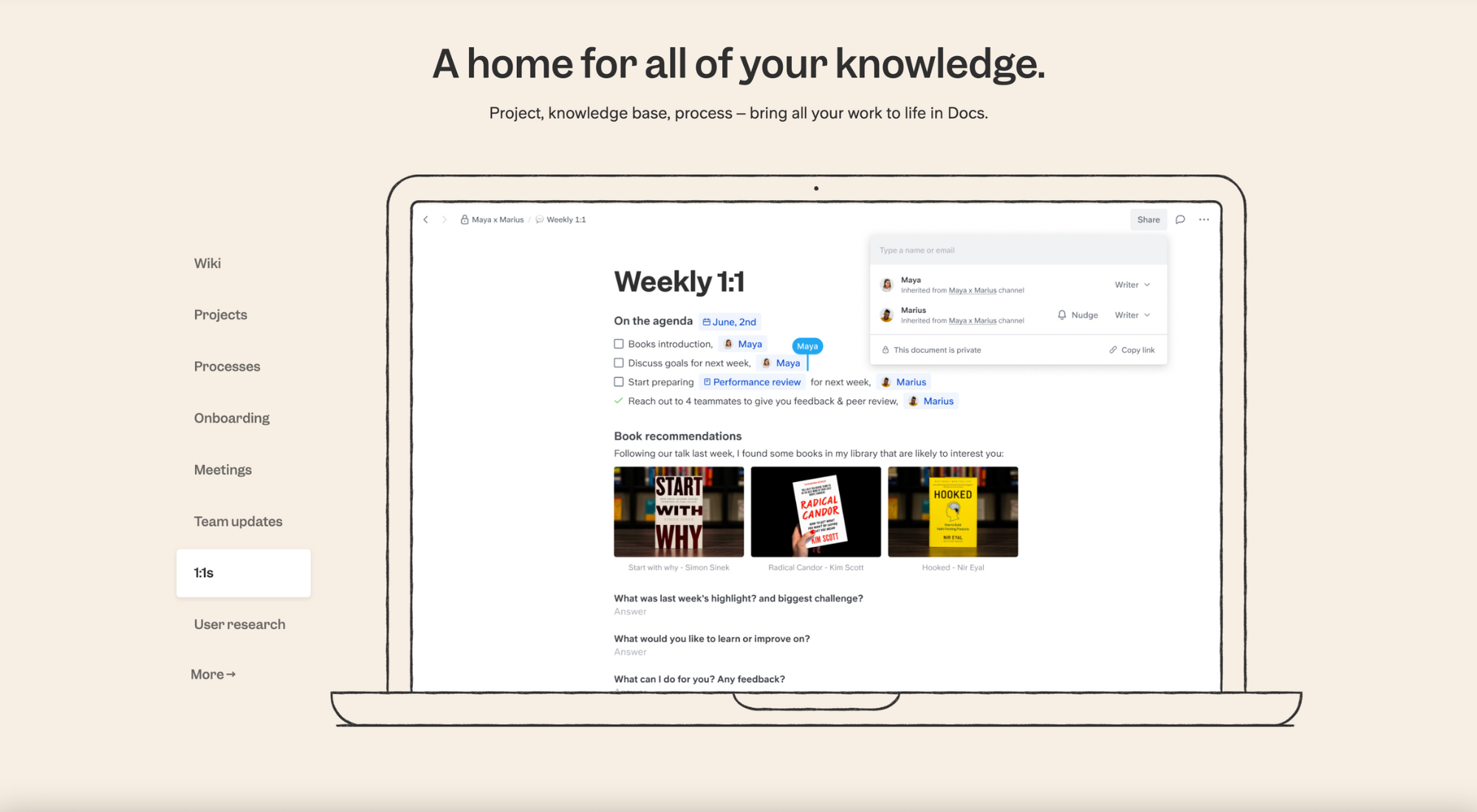HR Writer & Editor
The 5 Best One-on-One Meeting Tools for Your Team

4 min read
Published: Dec 1, 2022
Revised on: May 23, 2024
- Assembly
- Easy to use and intuitive interface. Many reviews mentioned Assembly is simple, easy to navigate, and user-friendly.
- Good customer support. Reviews mentioned Assembly's support team is responsive in resolving issues.
- Rewards redemption process is smooth. Users liked the gift card and other reward options that can be redeemed with points.
- Integrates well with Slack and Microsoft Teams. The integration makes giving recognition quick and seamless.
- Good for employee recognition and engagement. Reviews highlighted Assembly's peer-to-peer recognition features that help boost employee morale.
- Slite
- Easy to use and intuitive interface. Many reviewers mentioned how simple and straightforward Slite is to use.
- Good for collaboration. Allows for real-time collaboration on documents and easy sharing.
- Well-organized structure. Makes it easy to organize notes, documents, and information in a logical hierarchy.
- Feature-rich. Offers a comprehensive set of features like embedded media, templates, exports, etc.
- Mobile apps. Has mobile apps available across platforms like iOS and Android.
- Fellow
- Easy to take notes and assign action items during meetings. Many reviews mentioned how Fellow makes meetings more productive by streamlining note-taking and tracking follow-ups.
- Integrates well with other tools like Google Calendar, Slack, Asana, etc. Reviews highlighted the convenience of Fellow's integrations with commonly used work apps.
- Provides meeting templates and agendas. Reviews liked having templates to structure meetings and prepare in advance.
- Keeps all meeting notes organized in one place. Reviews noted how Fellow consolidates meeting notes for easy reference.
- Allows collaboration on notes and agendas. Reviews appreciated the ability to co-edit meeting notes and agendas.
- SuperSaaS
- Easy to use and set up for both administrators and clients/users. Many reviewers mentioned the intuitive interface.
- Highly customizable and flexible to meet different business needs. Reviewers highlighted the ability to tailor SuperSaaS to their specific requirements.
- Excellent and responsive customer support. Many reviewers praised the quick and helpful support they received.
- Affordable pricing, especially for small businesses. Reviewers liked the value offered by SuperSaaS.
- Reliable service with good uptime. Reviewers said SuperSaaS is stable and consistently available.
- Zoom
- Easy to use and intuitive interface - Many reviewers mentioned Zoom is very easy to use, even for those less tech-savvy. The interface is clean, simple, and intuitive.
- High quality audio/video - Reviewers consistently praised the high-quality video and audio provided by Zoom, resulting in smooth, clear communication.
- Useful features like screen sharing, chat, recording - Features like screen sharing, chat, breakout rooms, and the ability to record meetings make Zoom useful for collaboration and engagement.
- Reliable performance - Reviewers said Zoom provides a reliable conferencing experience, even on slower networks. It rarely crashes or lags.
- Widely used/cross-platform - Zoom works across devices and platforms, and its widespread use makes it easy when inviting others to meetings.
In today's fast-paced business landscape, effective one-on-one interactions between team members, managers, and stakeholders are paramount for fostering understanding, resolving issues, and driving organizational success. This curated list brings five exceptional tools specifically designed to streamline and optimize one-on-one meetings, equipping you with the means to facilitate productive conversations, build stronger relationships, and achieve operational efficiency within your work environment. The features and capabilities of these leading platforms can revolutionize how you conduct individualized discussions and maximize productivity.
What Should Be Covered in a One-on-One Meeting?
While a one-on-one meeting agenda depends on the length and frequency of meetings, the best one-on-one sessions touch on three main areas:
- Performance
- Growth and development
- Goal setting
How Do You Evaluate and Improve Employee Performance?
One-on-ones between managers and employees are an optimal way to evaluate and improve an employee’s performance at work.
If a job requires employees to consistently meet short-term goals, a standing one-on-one meeting is an excellent way to check your employee’s status and problem-solve if necessary. If your employees typically work on longer-term projects, one-on-ones can keep you apprised of their progress and help you develop shorter-term goals to keep everything on track.
Individual meetings allow you to tailor your feedback to each employee, letting you focus on an employee’s specific strengths and weaknesses. Information gathered during one-on-one meetings can help managers pair their employees with the projects that best suit their interests and abilities.
What Is the Importance of Professional Growth and Professional Development?
One-on-ones provide an ideal forum for managers to discuss growth and development opportunities with their employees. A recent Gallup poll found that 87% of millennials value growth and professional development in their jobs, and employees will quickly tire of a position that doesn’t offer room for professional growth.
Managers should dedicate time during a one-on-one to discuss their employee’s career aspirations and specific interests, and communicate ways in which they can help that employee achieve their personal work goals.
By showing interest and investing in your employee’s professional development, your employees will be more likely to remain at the company and thrive at their jobs.
How Do You Introduce Goal Setting to Employees?
Set specific, measurable goals with your employees during one-on-ones and check their progress at your next meeting. Learning about your employee’s particular work style during one-on-ones can help you and your employee formulate professional goals based on their unique skills and workplace habits.
The most effective goals are tailored to the individual. Ask your employees about their aspirations and try to set professional goals that allow them to flourish along these lines. Provide clear and encouraging feedback at each one-on-one meeting with a manager to optimize their progress.
How Can a One-on-One Tool Improve Your Meetings?
One-on-one tools are organizational platforms that streamline individual meetings through increased efficiency and clear communication. An ideal one-on-one meeting tool includes:
- Meeting platform for visual or verbal communication
- Organizational tool for keeping track of past notes
- Central location to document decisions made during the meeting
There are one-on-one meeting templates and direct reports templates you can utilize to help integrate and systematize workflow by increasing structure, consistency, and visibility. Organizational platforms like the ones listed below allow employees to respond directly to engaging questions about their career aspirations and additional support they may need at work.
5 Best Tools to Make the Most of Your One-on-One Meetings
Assembly offers several highly-effective and user-friendly workplace solution tools to optimize one-on-ones. Over 3,000 organizations currently use Assembly to meet their workplace needs. Assembly provides templates for both one-on-one meetings and employee direct reports and specifies the best questions to ask your employees during meetings.
Meeting Template:
Assembly’s one-on-one meeting templates allow managers and employees to track project progress, set goals, and problem-solve. These templates serve as guidelines for what you hope to accomplish during a meeting and help ensure everyone is on the same page.
A meeting template allows managers and employees to prepare their thoughts and questions beforehand so the meeting itself can run smoothly and efficiently without anything slipping through the cracks. Meeting templates also let employees review the meeting agenda afterward to remind themselves of specifics.
Assembly’s meeting templates ensure that the most up-to-date information is readily available to everyone involved.
Direct Reports:
Assembly understands the importance of hearing directly from employees about their workplace experiences. With Assembly’s direct reports template, employees can answer specific questions about their career aspirations and individual goals and offer feedback on what they want to see implemented in the workplace.
As a manager, you may find that direct reporting produces clearer and more helpful information than you may receive when asking for general feedback. Assembly offers suggestions on effective questions to ask your employees, but managers can adapt the platform to suit their needs.
Sample Questions:
Assembly provides examples of one-on-one meeting questions you should ask your employees to enhance the productivity of your meetings. The best questions ask about personal priorities, goals, coworkers, and life outside the workplace. These typically include the following.
- What are your top priorities for the week?
- Is there anything you currently need help with?
- How do you feel about the next three months?
- What has been your work highlight this week? Lowlight?
- How is life outside of work?
Pros
- Easy to use and intuitive interface. Many reviews mentioned Assembly is simple, easy to navigate, and user-friendly.
- Good customer support. Reviews mentioned Assembly's support team is responsive in resolving issues.
- Rewards redemption process is smooth. Users liked the gift card and other reward options that can be redeemed with points.
- Integrates well with Slack and Microsoft Teams. The integration makes giving recognition quick and seamless.
- Good for employee recognition and engagement. Reviews highlighted Assembly's peer-to-peer recognition features that help boost employee morale.
Cons
- Limitations in analytics and reporting features. Some reviews wanted more detailed analytics and user statistics.
- Creating flows and automations can be tricky. Reviews noted workflows and automations are sometimes hard to setup.
- Limited customization options for recognitions. Users wanted more ways to customize recognitions with images/GIFs.
- Lack of mobile apps earlier on. Reviews mentioned lack of mobile apps made it hard to use when not by a computer.
- Confusion due to branding changes. Reviews noted frequent name changes of the reward units was confusing initially.
Slite
Created for remote teams, Slite makes it possible for workplaces to gather asynchronous employee discussions and work documents in a single place. Slite eliminates confusion by helping teams align and collaborate even when working at different times from different locations.
Slite also provides users with templates for company handbooks, meeting notes, and product lists.
Pricing plans range from absolutely free to premium, depending on the needs of your workplace.
Try a full demo herePros
- Easy to use and intuitive interface. Many reviewers mentioned how simple and straightforward Slite is to use.
- Good for collaboration. Allows for real-time collaboration on documents and easy sharing.
- Well-organized structure. Makes it easy to organize notes, documents, and information in a logical hierarchy.
- Feature-rich. Offers a comprehensive set of features like embedded media, templates, exports, etc.
- Mobile apps. Has mobile apps available across platforms like iOS and Android.
Cons
- Slow performance at times, especially on mobile. Some users complained of lag and slowness.
- Formatting limitations. Does not offer very advanced formatting options for documents.
- Navigation can be tricky. As folder structures grow, some found it hard to navigate and find docs.
- Pricing model not flexible. The pricing tiers are not adaptable to different team sizes.
- Search needs improvement. The search function could be better optimized to find relevant docs.
Fellow
Fellow is a one-on-one meeting app that allows managers and employees to collaborate on meeting agendas, assign tasks, and exchange feedback in a single location.
Fellow offers time-saving templates to drive meeting engagement and productivity. With all the meeting action items in one place, everyone can stay apprised and be accountable for their responsibility.
Pros
- Easy to take notes and assign action items during meetings. Many reviews mentioned how Fellow makes meetings more productive by streamlining note-taking and tracking follow-ups.
- Integrates well with other tools like Google Calendar, Slack, Asana, etc. Reviews highlighted the convenience of Fellow's integrations with commonly used work apps.
- Provides meeting templates and agendas. Reviews liked having templates to structure meetings and prepare in advance.
- Keeps all meeting notes organized in one place. Reviews noted how Fellow consolidates meeting notes for easy reference.
- Allows collaboration on notes and agendas. Reviews appreciated the ability to co-edit meeting notes and agendas.
Cons
- Can take some time to learn all the features. Some reviews found the app overwhelming at first with many options to learn.
- Formatting limitations when exporting notes. Reviews noted issues with retaining formatting when exporting notes to share externally.
- No easy way to search historical notes. Reviews wanted better search and tagging for finding old notes.
- Assigning tasks only to Fellow users. Reviews wanted the ability to assign tasks to anyone, not just Fellow users.
- Recurring meetings can get disorganized. Reviews noted issues with recurring meetings getting duplicated or disorganized over time.
The appointment scheduling software and reservation system SuperSaas allows employers and employees to manage all the company’s resources, services, and locations in a single bookable online calendar.
With SuperSaas, you can send automated SMS or email meeting reminders, integrate links for video conferencing, and create lists of time slots for available one-on-one meetings.
Test the service for free or opt for a paid plan with more capabilities.
Pros
- Easy to use and set up for both administrators and clients/users. Many reviewers mentioned the intuitive interface.
- Highly customizable and flexible to meet different business needs. Reviewers highlighted the ability to tailor SuperSaaS to their specific requirements.
- Excellent and responsive customer support. Many reviewers praised the quick and helpful support they received.
- Affordable pricing, especially for small businesses. Reviewers liked the value offered by SuperSaaS.
- Reliable service with good uptime. Reviewers said SuperSaaS is stable and consistently available.
Cons
- The interface could be more modern, sleek and user-friendly. Some reviewers found the interface a bit dated.
- Initial setup can be complex and time-consuming. The high customizability means a learning curve for administrators.
- Mobile experience needs improvement. The mobile interface was identified as an area for improvement.
- Reporting and analytics functionality is limited. Reviewers wanted more robust reporting features.
- Lack of native integrations with payment systems and other software. Reviewers wanted more out-of-the-box integrations.
Zoom
Zoom is a commonly used source for workplace video conferencing and presentations. Zoom conferencing allows employees to see each other face-to-face for direct and meaningful conversations. Zoom is often used in remote schooling because it is easy to use and allows for screen sharing.
Anyone can host a meeting on Zoom, which is free. However, you may have to pay if you plan to use the platform frequently or for an extended period because the free version times out after 40 minutes.
Pros
- Easy to use and intuitive interface - Many reviewers mentioned Zoom is very easy to use, even for those less tech-savvy. The interface is clean, simple, and intuitive.
- High quality audio/video - Reviewers consistently praised the high-quality video and audio provided by Zoom, resulting in smooth, clear communication.
- Useful features like screen sharing, chat, recording - Features like screen sharing, chat, breakout rooms, and the ability to record meetings make Zoom useful for collaboration and engagement.
- Reliable performance - Reviewers said Zoom provides a reliable conferencing experience, even on slower networks. It rarely crashes or lags.
- Widely used/cross-platform - Zoom works across devices and platforms, and its widespread use makes it easy when inviting others to meetings.
Cons
- Privacy/security concerns - There were complaints about previous security issues like Zoombombing and privacy concerns around data handling.
- Meeting limits in free version - The 40-minute limit on group meetings in the free version was frequently cited as a downside.
- Video meeting fatigue - Staring at screens for hours during back-to-back Zoom meetings can be tiring and draining.
- Technical glitches - Occasional issues with audio, connectivity problems, or other technical glitches were mentioned as frustrations.
- Pricing concerns - Some felt the pricing for paid plans is too high, especially for smaller teams/businesses.
Conclusion
One-on-one meetings between employees and managers are crucial to the success of almost every business. These meetings offer uninterrupted time to discuss projects and responsibilities, review employee performance, and remove any impeding roadblocks. Whether conducted in person or virtually, a one-on-one meeting is a unique opportunity for employers and managers to get to know their employees personally.



-1f43ba0a755f2885c29ef7308a2c500d.webp?3432)







